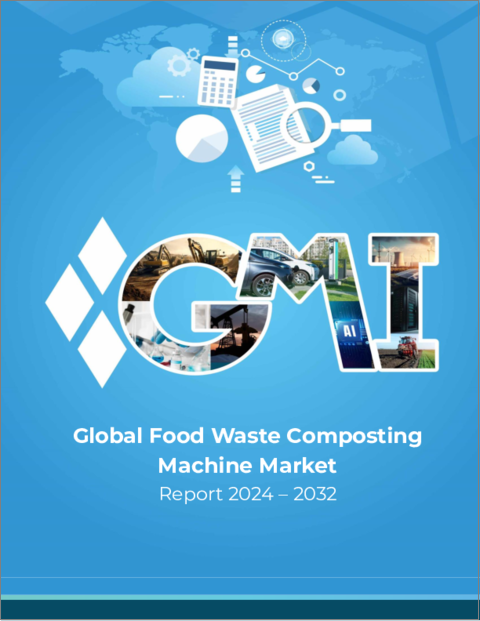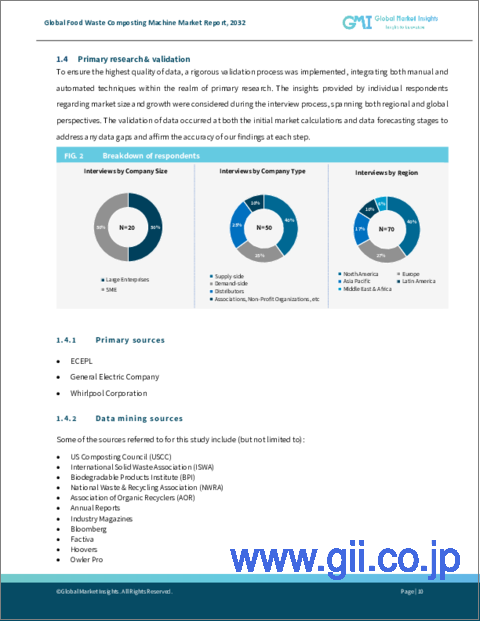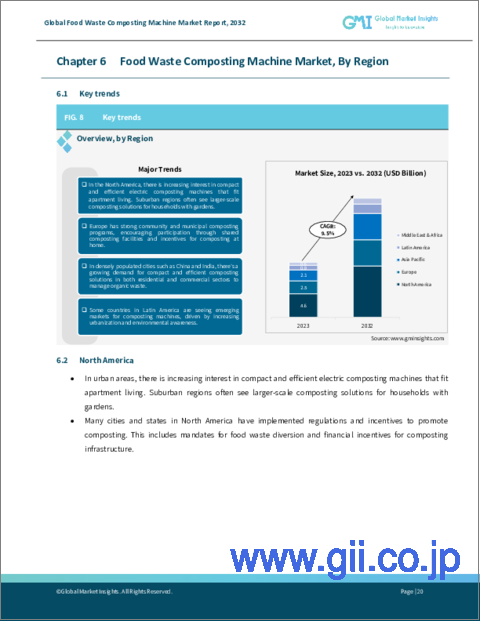|
|
市場調査レポート
商品コード
1544709
生ごみ堆肥化機市場、市場機会、成長促進要因、産業動向分析と予測、2024-2032年Food Waste Composting Machine Market, Opportunity, Growth Drivers, Industry Trend Analysis and Forecast, 2024-2032 |
||||||
カスタマイズ可能
|
|||||||
| 生ごみ堆肥化機市場、市場機会、成長促進要因、産業動向分析と予測、2024-2032年 |
|
出版日: 2024年07月15日
発行: Global Market Insights Inc.
ページ情報: 英文 340 Pages
納期: 2~3営業日
|
- 全表示
- 概要
- 目次
世界の生ごみ堆肥化機市場は、2024年から2032年にかけてCAGR 9.5%を記録します。
この成長は、環境に対する関心の高まりと食品廃棄物の削減を目的とした政府規制によって、持続可能な廃棄物管理の実践が重視されるようになったことが主な要因です。例えば、国連食糧農業機関によると、世界で生産される全食品の約3分の1が廃棄されており、効果的な廃棄物管理ソリューションの緊急の必要性が浮き彫りになっています。都市人口が増加し続け、産業活動が拡大するにつれて、効率的な堆肥化ソリューションへの需要が急増し、特に欧州を中心とする様々な地域での市場拡大を支えるものと予想されます。
生ごみ堆肥化機市場では、2032年までに非電化部門が大きなシェアを占めると思われます。生ごみ堆肥化機は、環境に優しく、運転コストが低く、エネルギー消費量が少ないことから人気を集めています。中小規模の事業用に設計された非電化コンポスト機は、住宅地、中小企業、電力アクセスが制限された遠隔地における生ごみ管理のための効率的なソリューションを提供します。持続可能な廃棄物管理の利点に関する意識の高まりと、環境に配慮した慣行の採用の増加は、このセグメントの成長を推進する主要な促進要因です。
商業セグメントは、2024年から2032年にかけて生ごみ堆肥化機市場で大きな成長を遂げる見通しです。企業の社会的責任(CSR)と環境の持続可能性への注目が高まる中、ホスピタリティ、フードサービス、小売部門の企業は、生ごみをより効果的に管理するために業務用コンポスト機に投資しています。これらの機械は、廃棄物処理コストの削減に役立つだけでなく、有機廃棄物を貴重な堆肥に変えることで、企業のグリーン・イニシアチブにも貢献しています。廃棄物ゼロ作戦の動向の高まりと、適切な生ごみ処理を義務付ける政府の厳しい規制が、業務用生ごみ堆肥化機の採用をさらに後押ししています。
欧州は、2024年から2032年にかけて世界の生ごみ堆肥化機市場の顕著な成長を牽引します。この地域は、厳しい環境規制と持続可能な実践に対する高い意識に沿った廃棄物管理インフラが確立されており、堆肥化機の主要市場として位置づけられています。欧州各地の政府は、循環型経済の目標達成に向けた幅広い取り組みの一環として、有機廃棄物のリサイクルと堆肥化を促進するイニシアチブを支援する動きを強めています。さらに、堆肥化装置の技術的進歩や、この地域の大手業界企業の存在は、市場の成長をさらに加速させる可能性が高いです。
目次
第1章 調査手法と調査範囲
第2章 エグゼクティブサマリー
第3章 業界洞察
- エコシステム分析
- バリューチェーンに影響を与える要因
- 利益率分析
- 破壊
- 将来の展望
- メーカー
- 流通業者
- 小売業者
- 業界への影響要因
- 促進要因
- 一般家庭および商業施設での採用の増加
- 政府の取り組みと政策支援
- 堆肥化の利点とプロセスに関する認識と教育の欠如
- 業界の潜在的リスク&課題
- 堆肥化の利点とプロセスに関する認識と教育の欠如
- 促進要因
- 消費者の購買行動分析
- 人口動向
- 購買決定に影響を与える要因
- 消費者の製品採用
- 好みの流通経路
- 希望価格帯
- 成長可能性分析
- ポーター分析
- PESTEL分析
- ポーター分析
第4章 競合情勢
- 企業シェア分析
- 競合のポジショニング・マトリックス
- 戦略展望マトリックス
第5章 市場推計・予測:タイプ別
- 主要動向
- 電気式
- 非電気式
第6章 市場推計・予測:容量別
- 主要動向
- 0~50kg/日
- 50~100kg/日
- 101-300kg/日
- 301-500kg/日
- 501-1000kg/日
- 1000kg/日以上
第7章 市場推計・予測:価格別
- 主要動向
- 低価格帯
- 中価格帯
- 高価格帯
第8章 市場推計・予測:用途別
- 主要動向
- 住宅用
- 商業施設
- オフィス
- レストラン
- ホテル
- 食品加工センター
- 堆肥化施設
- その他(スーパーマーケット、軍/鉱山キャンプなど)
第9章 市場推計・予測:流通チャネル別
- 主要動向
- 直接販売
- 間接販売
第10章 市場推計・予測:地域別
- 主要動向:地域別
- 北米
- 米国
- カナダ
- 欧州
- ドイツ
- 英国
- フランス
- イタリア
- スペイン
- その他欧州
- アジア太平洋
- 中国
- インド
- 日本
- 韓国
- オーストラリア
- その他アジア太平洋地域
- ラテンアメリカ
- ブラジル
- メキシコ
- アルゼンチン
- その他ラテンアメリカ
- 中東・アフリカ
- サウジアラビア
- UAE
- 南アフリカ
- その他の中東・アフリカ
Global Food Waste Composting Machine Market will witness a 9.5% CAGR from 2024 to 2032. This growth is largely attributed to the increasing emphasis on sustainable waste management practices, driven by rising environmental concerns and government regulations aimed at reducing food waste. For instance, according to the Food and Agriculture Organization, approximately one-third of all food produced globally is wasted, highlighting the urgent need for effective waste management solutions. As urban populations continue to grow and industrial activities expand, the demand for efficient composting solutions is expected to surge, supporting market expansion across various regions, particularly in Europe.
The overall food waste composting machine industry is categorized based on type, capacity, price, application, distribution, and region.
The non-electric segment will capture a substantial share of the food waste composting machine market by 2032. These machines are gaining popularity due to their eco-friendly nature, low operational costs, and minimal energy consumption. Designed for small to medium-scale operations, non-electric composting machines offer an efficient solution for managing food waste in residential areas, small businesses, and remote locations with limited electricity access. The rising awareness about the benefits of sustainable waste management and the growing adoption of eco-conscious practices are key drivers propelling the growth of this segment.
The commercial segment is poised to experience significant growth in the food waste composting machine market over 2024-2032. With the increasing focus on corporate social responsibility (CSR) and environmental sustainability, businesses in the hospitality, food service, and retail sectors are investing in commercial composting machines to manage food waste more effectively. These machines not only help reduce waste disposal costs but also contribute to a company's green initiatives by turning organic waste into valuable compost. The rising trend of zero-waste operations and stringent government regulations mandating proper food waste disposal are further boosting the adoption of commercial food waste composting machines.
Europe will drive commendable growth in the global food waste composting machine market from 2024 to 2032. The region's well-established waste management infrastructure, in line with stringent environmental regulations and high awareness of sustainability practices, positions it as a key market for composting machines. Governments across Europe are increasingly supporting initiatives that promote organic waste recycling and composting as part of broader efforts to achieve circular economy goals. Moreover, technological advancements in composting equipment and the presence of leading industry players in the region are likely to further accelerate market growth.
Table of Contents
Chapter 1 Methodology and Scope
- 1.1 Market scope and definitions
- 1.2 Research design
- 1.2.1 Research approach
- 1.2.2 Data collection methods
- 1.3 Base estimates and calculations
- 1.3.1 Base year calculation
- 1.3.2 Key trends for market estimation
- 1.4 Forecast model
- 1.5 Primary research and validation
- 1.5.1 Primary sources
- 1.5.2 Data mining sources
Chapter 2 Executive Summary
- 2.1 Industry 360° synopsis
Chapter 3 Industry Insights
- 3.1 Industry ecosystem analysis
- 3.1.1 Factor affecting the value chain
- 3.1.2 Profit margin analysis.
- 3.1.3 Disruptions
- 3.1.4 Future outlook
- 3.1.5 Manufacturers
- 3.1.6 Distributors
- 3.1.7 Retailers
- 3.2 Industry impact forces
- 3.2.1 Growth drivers
- 3.2.1.1 Increasing adoption in households and commercial establishments
- 3.2.1.2 Government initiatives and policy support
- 3.2.1.3 Lack of awareness and education about the benefits and processes of composting
- 3.2.2 Industry pitfalls and challenges
- 3.2.2.1 Lack of awareness and education about the benefits and processes of composting
- 3.2.1 Growth drivers
- 3.3 Consumer buying behavior analysis
- 3.3.1 Demographic trends
- 3.3.2 Factors affecting buying decision
- 3.3.3 Consumer product adoption
- 3.3.4 Preferred distribution channel
- 3.3.5 Preferred price range
- 3.4 Growth potential analysis
- 3.5 Porter's analysis
- 3.6 PESTEL analysis
- 3.7 Porter's analysis
Chapter 4 Competitive Landscape, 2023
- 4.1 Company market share analysis
- 4.2 Competitive positioning matrix
- 4.3 Strategic outlook matrix
Chapter 5 Market Estimates and Forecast, By Type (USD Billion) (Million Units)
- 5.1 Key trends
- 5.2 Electric
- 5.2 Non-electric
Chapter 6 Market Estimates and Forecast, By Capacity (USD Billion) (Million Units)
- 6.1 Key trends
- 6.2 0-50 kg/day
- 6.3 50- 100 kg/day
- 6.4 101- 300 kg/day
- 6.5 301-500 kg/day
- 6.6 501-1000 kg/day
- 6.7 Above 1000 kg/day
Chapter 7 Market Estimates and Forecast, By Price (USD Billion) (Million Units)
- 7.1 Key trends
- 7.2 Low
- 7.3 Medium
- 7.4 High
Chapter 8 Market Estimates and Forecast, By Application (USD Billion) (Million Units)
- 8.1 Key trends
- 8.2 Residential
- 8.3 Commercial
- 8.3.1 Offices
- 8.3.2 Restaurants
- 8.3.3 Hotels
- 8.3.4 Food processing centers
- 8.3.5 Composting facilities
- 8.3.6 Others (supermarkets, military/mining camps, etc.)
Chapter 9 Market Estimates and Forecast, By Distribution Channel (USD Billion) (Million Units)
- 9.1 Key trends
- 9.1.1 Direct sales
- 9.1.2 Indirect sales
Chapter 10 Market Estimates and Forecast, By Region (USD Billion) (Million Units)
- 10.1 Key trends, by region
- 10.2 North America
- 10.2.1 U.S.
- 10.2.2 Canada
- 10.3 Europe
- 10.3.1 Germany
- 10.3.2 UK
- 10.3.3 France
- 10.3.4 Italy
- 10.3.5 Spain
- 10.3.6 Rest of Europe
- 10.4 Asia Pacific
- 10.4.1 China
- 10.4.2 India
- 10.4.3 Japan
- 10.4.4 South Korea
- 10.4.5 Australia
- 10.4.6 Rest of Asia Pacific
- 10.5 Latin America
- 10.5.1 Brazil
- 10.5.2 Mexico
- 10.5.3 Argentina
- 10.5.4 Rest of Latin America
- 10.6 MEA
- 10.6.1 Saudi Arabia
- 10.6.2 UAE
- 10.6.3 South Africa
- 10.6.4 Rest of MEA






